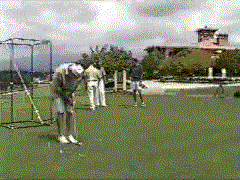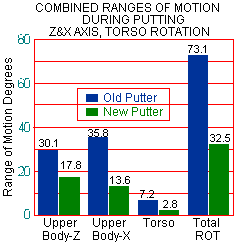Data Reduction |
|

|
The computer simulated motions of each putt for the two styles of putter used by the 6 golfers (12 total trials) were viewed to determine the frame that the end of backswing and ball contact occurred. The intersegmental joint angles for the shoulder, elbow, and wrist joints at the frame for the end of the backswing and ball contact were determined along the xy plane about the z axis and along the zy plane about the x axis. The xy plane of motion (z axis) identified the amount of flexion/extension occurring at these joints while the zy plane of motion (x axis) determined the amount of abduction/adduction occurring. |
The angular displacement (difference) between the backswing and contact positions represented the range of motion (ROM) occurring at the joints during the putting movement about the z and x axes. The sum of the shoulder, elbow, and wrist ROMs in the particular planes were identified as the upper body ROM about either the x or z axis. The change in the shoulder orientation taken from an overhead view for the backswing and contact frames represented the spinal rotation experienced by the torso during putting.
 The total of the joints of the upper body ROMs summed in the zy plane and the shoulder rotation represented the body movement that would produce lateral movement (right/left) from the desired putting line. The sum of the upper body ROMs along the xy plane (z axis) produced by flexion / extension of those joints would produce the forward/backward motion of the club head needed to strike the ball and push it towards the hole.
The total of the joints of the upper body ROMs summed in the zy plane and the shoulder rotation represented the body movement that would produce lateral movement (right/left) from the desired putting line. The sum of the upper body ROMs along the xy plane (z axis) produced by flexion / extension of those joints would produce the forward/backward motion of the club head needed to strike the ball and push it towards the hole.
A ratio between the ROMs found for the new putter and the old traditional putter was determined to show the percentage of reduction in the joint’s ROM that resulted from the new putter design. A ratio less than 1 or 100% would indicate that the prototype putter reduced the amount of motion necessary to complete the putt, thus making it more efficient and more likely to have less human error introduced while putting. The length of the putting stroke was measured from the backswing position to ball contact.  The effective putting radius for the traditional putter was determined by the displacement between the vertebrae at the base of the chin to the club head and the new style putter’s effective putting radius was between the shoulder joint and the club head.
The effective putting radius for the traditional putter was determined by the displacement between the vertebrae at the base of the chin to the club head and the new style putter’s effective putting radius was between the shoulder joint and the club head.
The golfer’s viewing angle represented the orientation of the eye plane in respect to the horizontal in the direction of the hole. If the eye plane was found to be 90 degrees then the head would be tilted sideways in respect to the horizontal. An 90 degree viewing orientation would result in the stereoscopic perspective being more sensitive to vertical deviations while an 0 degree or horizontal positioning would detect lateral putting errors. |
